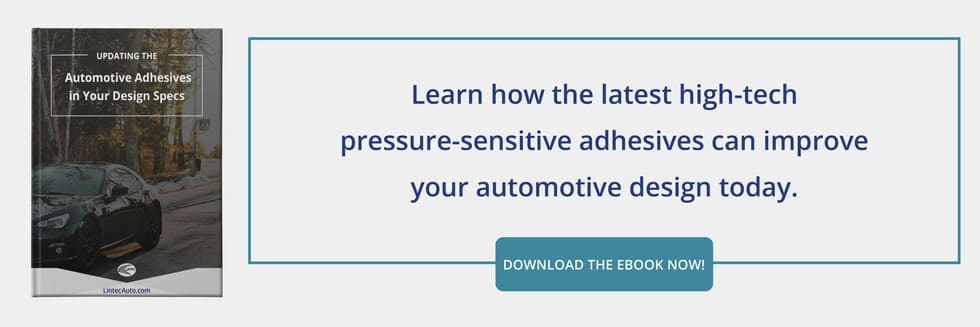Vibration and noise-reducing technologies have emerged as a top priority for 21st-century automotive design. Demand for comfort and quiet has increased even as vehicle weight has dropped. At first, it might seem like less mass in the vehicle would mean less shielding to isolate noise and rattles. However, due to the adhesive products automakers are using to cut weight, the opposite is often true.
Structural Adhesive Products—Cyanoacrylates, Urethanes, Epoxies, Acrylics
Mechanical fasteners are heavy, create focal points for stress, and require additional tooling of unfinished parts (e.g., for pilot holes, tapped holes, and torquing of fasteners). These are a few of the reasons automakers are replacing them with adhesive products that rigidify and strengthen the vehicle body. As a collateral benefit, a more rigid body means fewer rattles and less noise.
- Cyanoacrylates are liquids that harden in seconds and form consistent, full-surface-area bonds that won’t loosen or corrode over time, and require no punctures in the substrate.
- Epoxies have even higher strength and temperature resistance, but take more time to cure.
- Urethanes cure quickly into elastic bonds—ideal for areas where the coefficient of thermal expansion differs between substrates and flexibility can keep the bond consistent.
- Acrylic adhesive products can bond to the broadest range of substrates (LSE plastics, oily metals, composites) without any surface preparation. This ease-of-use suits them perfectly as automotive adhesive tapes.
While automotive structural adhesives can have a massive impact on NVH reduction—improving rigidity by 40% in GM’s 2013 CTS sedan, for example—many softer and less aggressive industrial adhesives are equally valuable for a quiet ride.
Anti-Vibration Tape—Polyurethane and Acrylic Foam
Automotive foam tapes are an emerging superstar because of their vibration-dampening properties. Grandview Research noted in 2015 that these foam adhesive products accounted for 40% of the overall revenue share (and the highest growth over their forecast period) in the NVH materials market. They’re anticipated to be a key factor for NVH materials growth through 2025 and beyond, largely due to their light weight and versatility. Automotive foam tapes can reduce noise and vibrations in all areas of the vehicle, such as:
- HVAC systems
- Floor and door insulation
- Mounting brackets
- Brakes
- Dashboard components
- Roof lining
- Cushioning of doors and hatches
- Window seals
Polyurethane (PUR) foams have high tensile strength, making them ideal for mounting of emblems, trim, and other small parts. They also have superior compression and dampening characteristics to other foams—great for NVH reduction.
Acrylic foams, by comparison, are typically more flexible and ductile. This suits them for bonding of long or narrow components (moldings, rocker panels, fenders, window frames, etc.), especially if thermal expansion is expected to be an issue.
Panel Hole Covers—LDPE and UHMW Polyethylene Films
One of the most common NVH culprits is through-holes in floorboards, doors, and the dash—perhaps left over from model changeovers or redesigns. These holes allow air to squeeze through, creating hissing and rumbling from wind noise. Low-density polyethylene (LDPE) makes a perfect film adhesive that can be die-cut to seal such panel holes.
Ultra-high molecular weight polyethylene also has a critical role in NVH control as an adhesive laminate. A layer of UHMW polyethylene film is self-lubricating and impact resistant. A thin laminate can prevent contacting metal surfaces (e.g. in doorframes or seating tracks) from squeaking or suffering friction abrasions.
Structural adhesives, foam tapes, and PE films have vastly different properties, but it takes a combination of all three to ace NVH ratings and provide drivers with a quiet ride.


